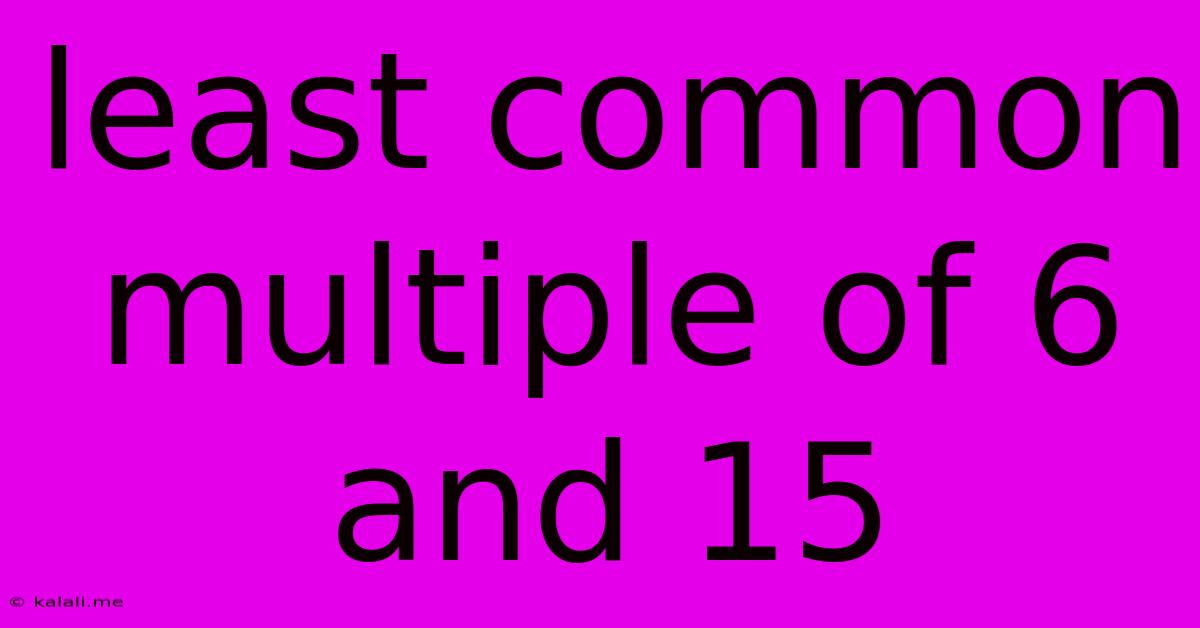Least Common Multiple Of 6 And 15
Kalali
May 09, 2025 · 3 min read

Table of Contents
Finding the Least Common Multiple (LCM) of 6 and 15: A Comprehensive Guide
Understanding the least common multiple (LCM) is crucial in various mathematical applications, from simplifying fractions to solving problems in number theory. This article will guide you through the process of finding the LCM of 6 and 15, explaining different methods and providing a clear understanding of the underlying concepts. We'll also explore how to approach finding the LCM for larger numbers.
What is the Least Common Multiple (LCM)?
The least common multiple (LCM) of two or more integers is the smallest positive integer that is divisible by all the integers. Think of it as the smallest number that contains all the original numbers as factors. For example, the LCM of 2 and 3 is 6, because 6 is the smallest number that is divisible by both 2 and 3. Finding the LCM is a fundamental concept in arithmetic and algebra.
Methods for Finding the LCM of 6 and 15
Several methods can be used to determine the LCM of 6 and 15. Let's explore two common approaches:
1. Listing Multiples Method
This method involves listing the multiples of each number until a common multiple is found.
- Multiples of 6: 6, 12, 18, 24, 30, 36...
- Multiples of 15: 15, 30, 45, 60...
The smallest multiple that appears in both lists is 30. Therefore, the LCM of 6 and 15 is 30.
This method is straightforward for smaller numbers but becomes less efficient for larger numbers.
2. Prime Factorization Method
This method is more efficient for larger numbers and provides a more systematic approach. It involves finding the prime factorization of each number and then constructing the LCM using the highest powers of each prime factor.
- Prime factorization of 6: 2 x 3
- Prime factorization of 15: 3 x 5
To find the LCM, we take the highest power of each prime factor present in either factorization:
- Highest power of 2: 2¹ = 2
- Highest power of 3: 3¹ = 3
- Highest power of 5: 5¹ = 5
Multiply these highest powers together: 2 x 3 x 5 = 30
Therefore, the LCM of 6 and 15, using prime factorization, is also 30. This method is generally preferred for its efficiency and applicability to larger numbers.
Applications of LCM
Understanding and calculating the LCM has various practical applications, including:
- Fraction addition and subtraction: Finding a common denominator when adding or subtracting fractions.
- Scheduling problems: Determining when events with different periodicities will occur simultaneously. For example, if two events occur every 6 days and 15 days respectively, they will occur together again after 30 days.
- Number theory: Solving problems related to divisibility and modular arithmetic.
Conclusion
Finding the least common multiple is a fundamental skill in mathematics with wide-ranging applications. Both the listing multiples method and the prime factorization method are effective, with the prime factorization method proving particularly useful for larger numbers. Mastering these methods allows for efficient problem-solving in various mathematical contexts. Remember that understanding the concept of prime factorization is key to unlocking efficient LCM calculations.
Latest Posts
Latest Posts
-
82 Inches To Feet And Inches
May 09, 2025
-
5 3 Cm Is How Many Inches
May 09, 2025
-
What State Of Matter Is The Outer Core
May 09, 2025
-
25 Is What Percentage Of 100
May 09, 2025
-
What Is 225 Degrees Celsius In Fahrenheit
May 09, 2025
Related Post
Thank you for visiting our website which covers about Least Common Multiple Of 6 And 15 . We hope the information provided has been useful to you. Feel free to contact us if you have any questions or need further assistance. See you next time and don't miss to bookmark.